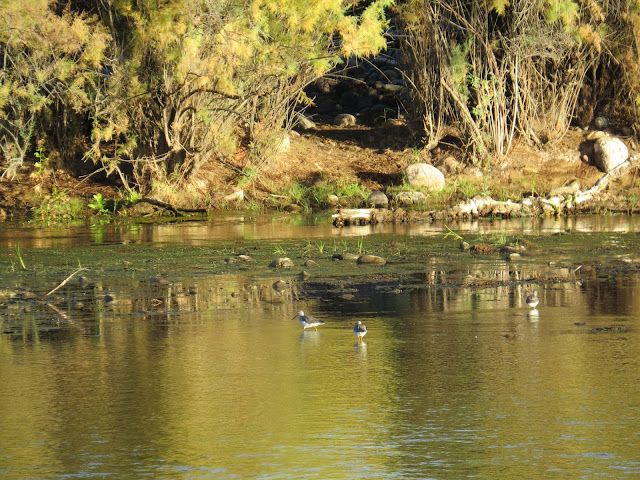Sunday, October 16th ROUSSEAU SOD FARMS (restricted access)
I arrived as the Full Hunter’s Moon began to set. With no farmers working the agricultural fields, I saw a nice variety of birds, including one rarity that I was absolutely thrilled to find.
 |
| WESTERN MEADOWLARK [above & below] |
 |
| SAVANNAH SPARROW [above and below] |
 |
| NORTHERN HARRIER |
 |
| Distant Coyote |
 |
| Rare (for Arizona) PALM WARBLER migrating through |
 |
| Rare PALM WARBLER showing its streaked breast; very yellow underbelly and under-tail coverts |
 |
| Yellow on PALM WARBLER also showing on top of tail in a bright olive appearance |
Tuesday, October 18th SALT RIVER-COON BLUFF RECREATION AREA
With a rare bird reported at one of my favorite birding spots -- one I hadn’t birded since June -- I ventured out early to see if I could locate the Magnolia Warbler.
Since I apparently don’t use the same route to the river as many birders, I wasn’t sure about the approximate location of the rarity at Coon Bluff, but I was early enough that warblers were not yet up and about. So, I parked at the second restroom and walked in the dirt road to the bluff as usual, then east along the Salt River, birding as I went.
Eventually, I was far from the parking area enjoying the birds I had seen: Bald Eagles (3), Greater Yellowlegs in the shallows of the very full fast-flowing Salt River, a Belted Kingfisher and many more.
With the sun now up, warblers were beginning to move. I was stunned when I saw the first one to perch up; it appeared to be the MAGNOLIA WARBLER in its basic plumage which I expected but had never seen. Showing no dark necklace and dark streaks of its breeding plumage, this bird was distinctive because of its gray head with clear compete white eye ring. This was NOT a Yellow-Rumped Warbler. It was quite yellow below with many more streaks along its flanks than I expected to see for non-breeding plumage, but also showed a white vent and under-tail coverts that are consistent with the MAWA. After studying it long enough to realize I had best get a photo, I lifted the camera and the bird flew. As I continued on, I noticed all of the Yellow-rumped Warblers that were now flying about and perching were very very pale underneath with the exception of a male that still was no match for the Magnolia.
A while later, I came upon other birder friends, Lindsay Story and her Dad, and Gordon Karre who, when I told him why I had some reservations about having seen the MAGNOLIA WARBLER, he showed me the photo posted in eBird by Rob Bowker, the birder who had reported it. The photo showed the extensive yellow and streaks on the underneath of the bird, restoring my confidence that I had seen the right bird. Getting a documentary photo of rarities is my goal, but in this case, I missed.
Wednesday, October 19th PINAL MOUNTAIN
With a Maricopa Audubon group of birders led by Dr. David Pearson (ASU), eight of us got an early start up the mountain east of Phoenix in Globe.
Cool temperatures kept us on our toes, eager to spot birds at our various stops, including the landfill where the gulls had not yet arrived but Common Ravens and Brewer’s Blackbirds were abundant.
We birded three distinct areas of the Pinals: the low area known as Russell Gulch, the ponderosa pine area known as Sulfide del Ray Campground, and Pinal Peak beginning with the presence of Douglas Firs.
As we slowly worked our way upward, stopping many times along the paved road to bird Russel Gulch, we noted many birds out and about below and above us. With a group, I rarely take many photos unless the bird is "in my lap" so to speak. Below are a few such pictures I managed to take.
 |
| Six Harvester Ant Hills that fascinated me with their neatness |
 |
| CHIPPING SPARROW |
 |
| RED-TAILED HAWK |
Not until we reached Pinal Peak did we gather to enjoy our carried lunch at one of the picnic tables.
 |
| L-R: Elithia, Barbara, Kate, Dr. Pearson, Sue, Kathe, Lisa |
Prior to heading directly down the mountain, we took Ferndell Loop to look for some specific birds that were no-shows, but the leaves turning color made up for the lack of more special birds.
 |
Photo by Lisa Augustyn
|
After hiking a few short trails on the Ferndell Loop, we all took some photos of the colorful autumn trees.
 |
| Enjoyed crunching through the fallen leaves instead of needing to rake them |
 |
| October Aspens in the Pinal Mountains |
 |
| Red-tailed Hawk |
A birding trip with Dr. Pearson and so many other birders pointing out what they saw provided me with a grand total of 64 species on this long day on the mountain. Quite a day from 6:30 a.m. until 2:30 p.m.
* * *
"Let's Make America Birdy Again"
(from Tucson Audubon magazine)
(from Tucson Audubon magazine)
View this checklist online at http://ebird.org/ebird/view/checklist/S32069835
View this checklist online at http://ebird.org/ebird/view/checklist/S32098239
View this checklist online at http://ebird.org/ebird/view/checklist/S32119264
View this checklist online at http://ebird.org/ebird/view/checklist/S32119475
View this checklist online at http://ebird.org/ebird/view/checklist/S32119654






No comments:
Post a Comment